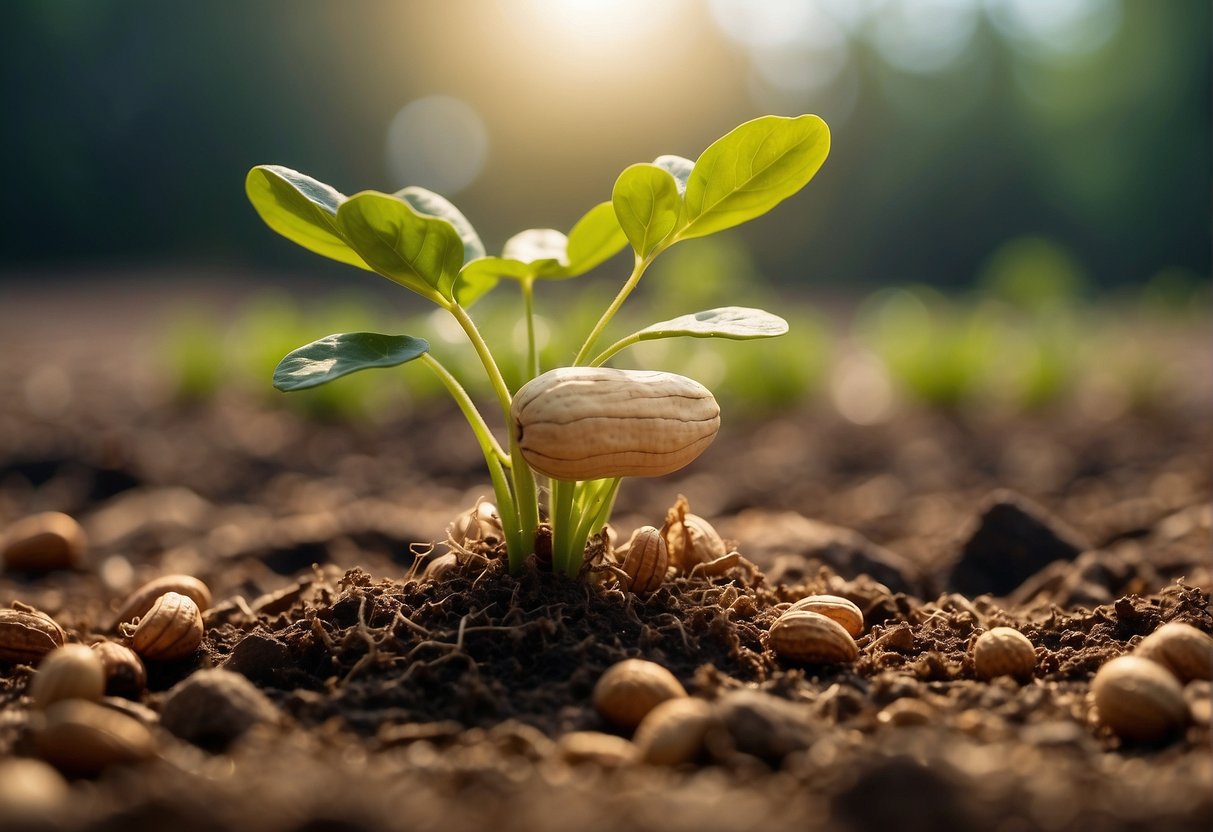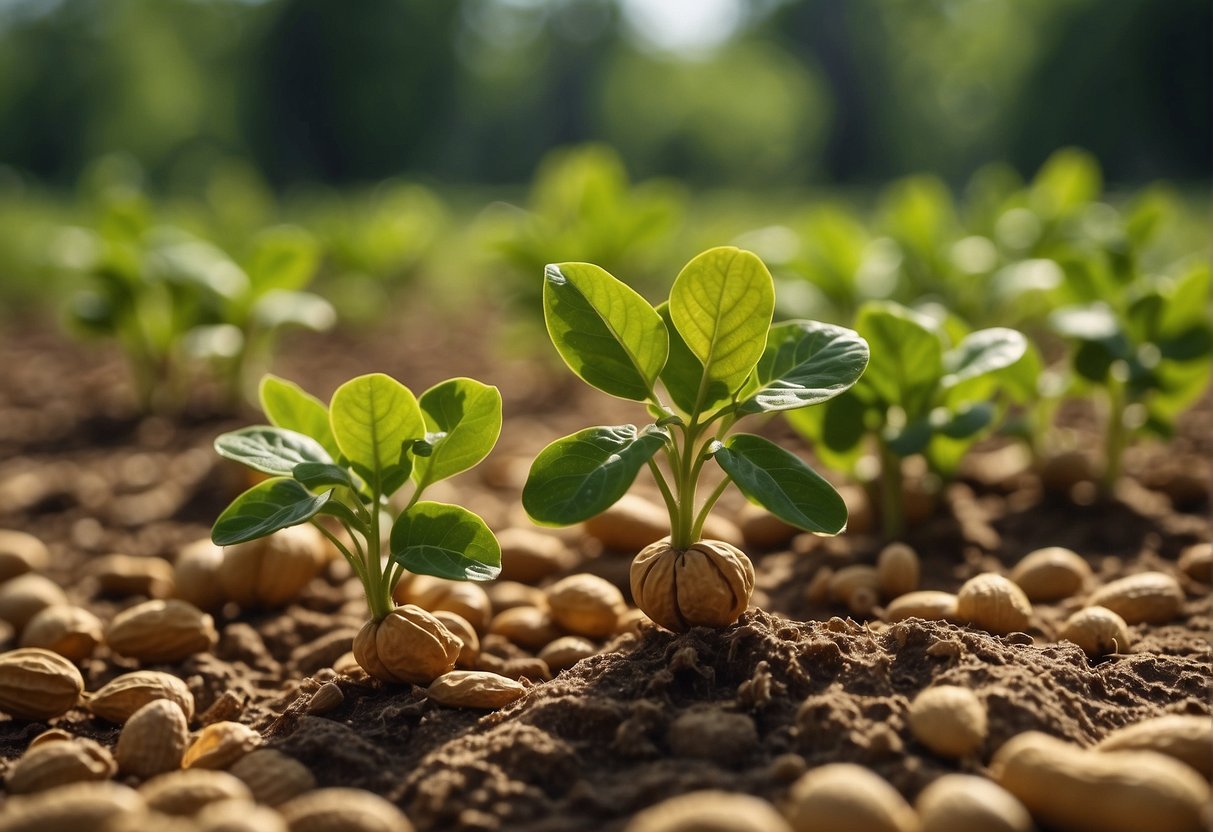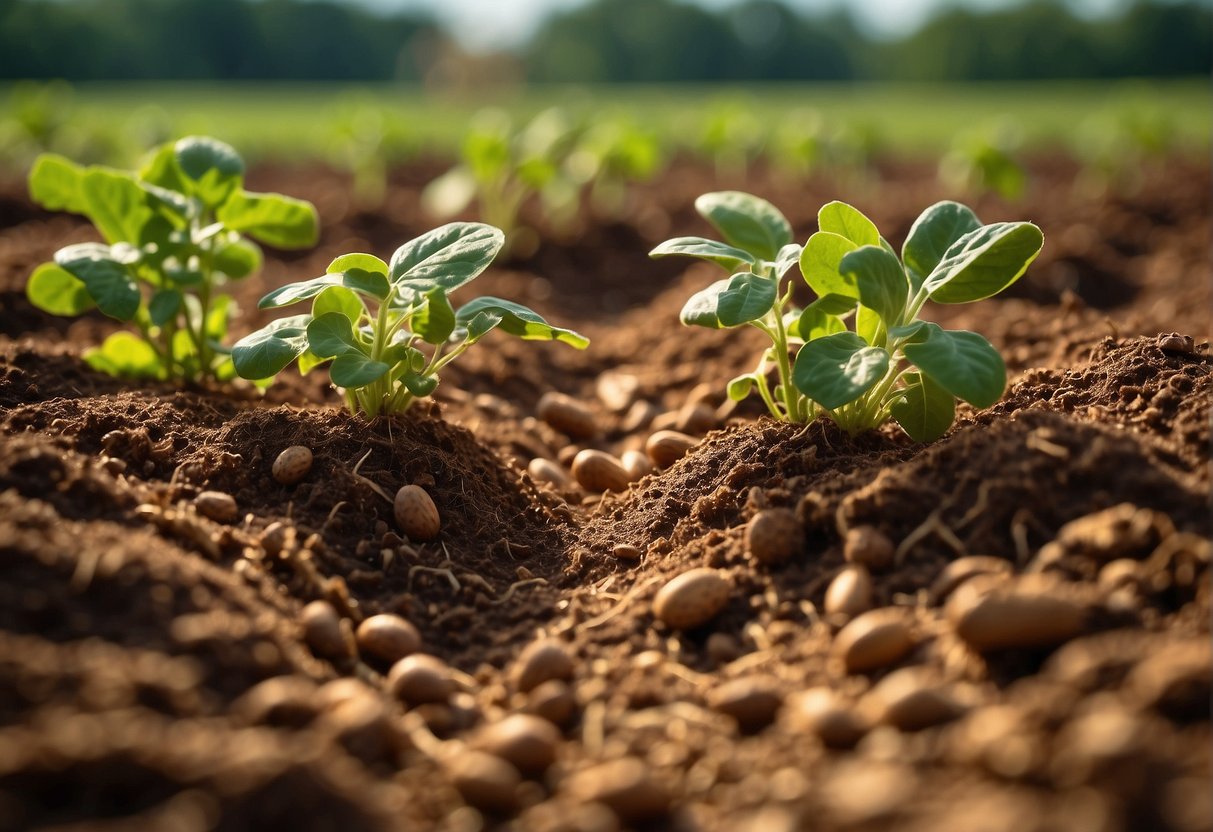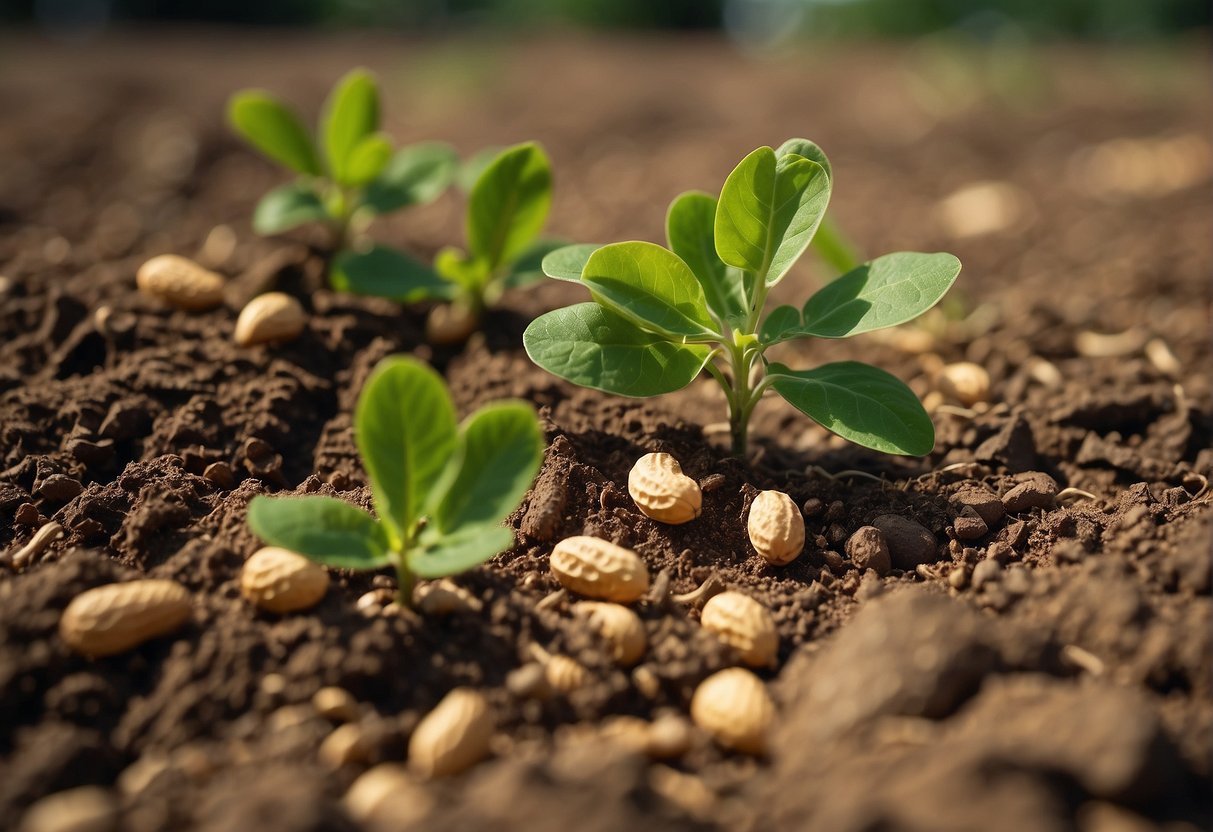Do Peanuts Grow Under the Ground? Explained
Peanuts are a popular snack all around the world, loved for their crunchy texture and nutty flavor. However, many people may not know where peanuts actually come from. Do peanuts grow under the ground? The answer is yes, peanuts do grow underground, but the process of their growth is a bit more complicated than that.

The peanut plant is a unique member of the legume family, and it grows in a fascinating way. The plant begins as a small yellow flower that eventually grows into a stem that can reach up to 18 inches tall. Once the flower is pollinated, it begins to grow a small peg that pushes down into the soil. This peg eventually becomes the peanut pod, which grows underground.
So while peanuts do grow underground, they actually begin their growth above the ground. Understanding the growth process of the peanut plant can help us appreciate the journey that these tasty snacks take from the field to our plates.
Peanut Plant Characteristics

Plant Structure
Peanut plants belong to the legume family and have a unique structure that sets them apart from other plants. The plant has a central stem with leaves that are arranged in an alternate pattern. The leaves are pinnate, meaning that they have multiple leaflets attached to a central stem. The plant can grow up to 2 feet tall and has a taproot system that can extend up to 4 feet deep into the soil.
One of the most unique characteristics of the peanut plant is the way it produces flowers. The flowers are produced on stalks that extend from the base of the plant and grow towards the ground. The flowers are self-pollinating and have both male and female parts.
Growth Cycle
The peanut plant has a unique growth cycle that takes approximately 120 to 150 days to complete. The plant begins as a seed, which is planted in the soil during the spring. The seed germinates and begins to grow, producing a small plant that eventually develops into a mature plant.
During the growth cycle, the plant produces yellow flowers that eventually turn into pods. The pods grow underground and contain the peanuts. The plant continues to grow and develop until it reaches maturity, at which point the leaves begin to turn yellow and fall off.
Once the plant has reached maturity, the farmer can harvest the peanuts. The peanuts are dug up from the ground and allowed to dry before they are processed and sold.
Overall, the peanut plant is a fascinating plant with unique characteristics that make it stand out from other plants. Its taproot system, self-pollinating flowers, and underground pods make it an interesting plant to study and grow.
Cultivation Practices
Soil Preparation
Peanuts require well-drained soil with a pH range of 5.8 to 6.2. Before planting, the soil should be prepared by removing weeds, rocks, and debris. The soil should also be tilled to a depth of 6 to 8 inches to loosen it and improve aeration. If the soil is heavy, adding organic matter such as compost or manure can improve drainage and fertility.
Planting and Irrigation
Peanuts are typically planted in rows that are 30 to 36 inches apart, with seeds spaced 2 to 4 inches apart in the row. The seeds should be planted 1 to 2 inches deep, depending on soil moisture. After planting, the soil should be watered thoroughly to ensure good seed-to-soil contact.
Once the plants have emerged, they should be irrigated regularly to ensure adequate moisture. Peanuts require about 1 to 1.5 inches of water per week, depending on the weather conditions. Overwatering can lead to disease and reduced yield, so it is important to monitor soil moisture levels and adjust irrigation accordingly.
Pest Management
Peanuts are susceptible to a variety of pests, including aphids, thrips, and mites. Pest management strategies include crop rotation, use of resistant varieties, and application of pesticides when necessary. It is important to follow label instructions when using pesticides and to avoid applying them during bloom, as this can harm pollinators.
In addition to pests, peanuts are also vulnerable to fungal diseases such as leaf spot and pod rot. To prevent these diseases, it is important to practice good crop management, including proper irrigation and fertilization, and to avoid planting in areas with a history of disease. Fungicides may also be used to control fungal diseases, but should be applied according to label instructions and in conjunction with other disease management practices.
Harvesting Process
Peanuts are harvested when the plants have matured and the leaves have turned yellow. The harvesting process involves pulling the entire plant out of the ground, shaking the excess soil off the roots, and then inverting the plant to allow it to dry in the sun for a few days.
From Pegs to Pods
Peanuts grow underground and are attached to the plant by pegs. The pegs are small stems that grow out of the base of the flower and penetrate the soil. As the peanut matures, the pegs elongate and push the developing pod underground.
When the peanut is ready to be harvested, the pegs will start to turn yellow and the leaves of the plant will begin to wilt. The farmer will then use a combine to pull the entire plant out of the ground.
Drying and Storage
After the plants have been harvested, they are left in the sun to dry for a few days. This allows the pods to dry out and makes them easier to separate from the pegs.
Once the pods have been removed from the plant, they are loaded onto a drying wagon and taken to a drying facility. The pods are then dried in a heated room until they reach a moisture content of around 10%.
After the pods have been dried, they are stored in a cool, dry place until they are ready to be processed. The pods can be stored for up to a year without losing their quality.
Nutritional and Economic Value

Health Benefits
Peanuts are a rich source of nutrients, including protein, fiber, healthy fats, and various vitamins and minerals. They are also high in antioxidants, which help protect against oxidative damage caused by free radicals. Peanuts are a good source of calcium, which is important for strong bones and teeth. In addition, they contain vitamin E, which is essential for healthy skin and eyes.
Research has also shown that consuming peanuts may have several health benefits. For example, studies have found that eating peanuts may help lower cholesterol levels and reduce the risk of heart disease. They may also help regulate blood sugar levels and reduce the risk of type 2 diabetes.
Peanut Products and Market
Peanuts are an important crop worldwide and are used in a variety of products. Peanut butter is one of the most popular peanut products and is consumed by millions of people around the world. Peanuts are also used in candy, snacks, and baked goods. In addition, they are used in the production of oil, which is used in cooking and as a source of fuel.
The peanut market is a significant part of the agricultural economy, with many countries producing and exporting peanuts. The United States is one of the largest producers of peanuts, followed by China, India, and Nigeria. The demand for peanuts and peanut products continues to grow, making it an important crop for farmers and a valuable commodity for consumers.
In conclusion, peanuts are a nutritious and versatile crop that provides a range of health benefits and economic value. With their high nutritional content and popularity in the market, it is clear that peanuts will continue to play an important role in the agricultural and food industries.
Global Peanut Production

Peanuts are one of the most widely grown crops in the world, with a total production of over 44 million metric tons in 2020. The majority of peanut production occurs in developing countries, particularly in Africa and Asia.
Major Peanut Producing Countries
The top five peanut producing countries in the world are China, India, Nigeria, the United States, and Sudan. These countries together account for over 70% of the world’s peanut production.
China
China is the largest peanut producer in the world, accounting for approximately one-third of global production. The country’s peanut production is concentrated in the Shandong, Henan, and Liaoning provinces.
India
India is the second-largest peanut producer in the world, with the majority of production concentrated in the states of Gujarat, Tamil Nadu, and Andhra Pradesh. The country exports a significant portion of its peanut crop to other countries.
Nigeria
Nigeria is the largest peanut producer in Africa and the third-largest in the world. The country’s peanut production is concentrated in the northern region, particularly in the states of Kano, Kaduna, and Bauchi.
United States
The United States is the fourth-largest peanut producer in the world, with the majority of production concentrated in the southern states of Georgia, Florida, Alabama, and Texas. The country is also a major exporter of peanuts.
Sudan
Sudan is the fifth-largest peanut producer in the world, with the majority of production concentrated in the western region of the country. The country’s peanut crop is primarily used for domestic consumption.
Overall, peanut production is an important industry in many developing countries and plays a significant role in global food security.
Frequently Asked Questions

How are peanuts cultivated and collected from the soil?
Peanuts are typically grown in warm climates with well-drained soils. The plants are first cultivated by planting seeds in the soil, which then grow into a mature plant with yellow flowers. After pollination, the flowers will wilt and the plant will begin to produce pods that grow underground. Once the plant has matured, the pods are harvested by digging them up from the soil.
What is the legal status of growing peanuts in certain areas?
The legality of growing peanuts varies depending on the region. In some areas, permits may be required to grow peanuts due to concerns about environmental impact or potential crop damage. It is important to check with local authorities to ensure that all regulations are being followed.
What is the growth cycle duration for a peanut plant?
The growth cycle for a peanut plant typically lasts around 120 to 150 days. During this time, the plant will undergo several stages of growth, including flowering and pod development. Once the pods have matured, they can be harvested and processed into various peanut products.
Can peanuts be found growing naturally in specific regions?
Peanuts are not typically found growing naturally in the wild. Instead, they are cultivated by farmers in specific regions where the climate and soil conditions are suitable for growth.
Do peanuts share the same underground growth characteristics as tubers like potatoes?
While peanuts do grow underground, they are not classified as tubers like potatoes. Instead, peanuts are classified as legumes, which means they are part of the same family as beans and peas.
Are peanuts unique in their subterranean development compared to other nuts?
Peanuts are unique in their subterranean development compared to other nuts, as they are the only nut that grows underground. Other nuts, such as almonds and walnuts, grow on trees above ground.
